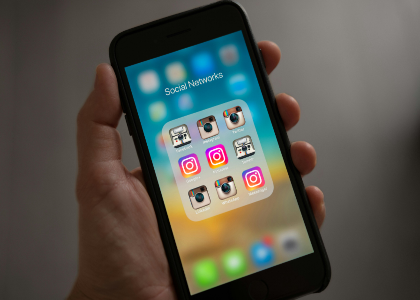Blog

What Are the Components of a Brand?
According to the Cambridge dictionary, “a brand is the act of giving a company a particular design or symbol in order to advertise its products and services”. This definition expands beyond just naming or symbolizing an organization’s vast offerings. Today, brands are treated as living things. They are conceived by the imagination of creators, brought into this world with unique names and personalities, and nurtured into fine characters that appeal to the masses it engages with.
Just like humans, a brand is nothing without the sum of its parts. Brand elements comprise a name, logo, color scheme, etc., that create an exclusive image of your business. It helps you stand out from your competitors and make your business a preferred choice for consumers, even in a crowded market.
A good branding exercise goes beyond fancy marketing budgets. It must be cohesive to your brand’s product or service and include developing a long-term strategy. A strategy ensures the longevity of your brand in the market. It resonates with your consumers, every time they think of a particular product category. Lastly, it sets a benchmark for a generation of brands to come.
Let’s take the example of Apple Inc. to understand this better. As soon as someone mentions the brand name, the brand component of a bitten apple comes to one’s mind. It then expands to the color scheme of a ‘white logo’ set upon a black or colorful background. The personality of Apple Inc. is an aesthetic-loving, technology-forward, and trendy brand. Consumers who use Apple products stand apart from the competitor’s cluttered market by opting for a higher value and a great quality product. They are even considered to be connoisseurs of innovative thinking and ideas, offered by Apple. This is the impact of branding on your business and the products you have to offer.
Even with the impact it has on your business and everything you stand for, branding is an intangible asset. It helps build aspirational value in the minds of your consumers, market, and industry as a whole.
So, what are the brand elements that make a memorable brand?
Let’s explore each of these elements and understand them better.
Brand USP
‘USP’ stands for ‘Unique Selling Point’. A brand’s USP defines a unique feature of a product or service that differentiates it from its competitors. Consumers are exposed to branded communication from multiple brands wherever they go. A USP helps consumers identify and resonate with your brand at a personal level. It serves to highlight an exclusive feature, a benefit, a visual differentiator, and clear communication.
USP is at the core of brand elements. It is an integral part of a strong brand strategy that has developed through the various phases of creating a brand.
A great example of building a solid USP is ‘FishWife’. The name of the brand itself is so intriguing and impactful that it immediately gets you thinking about what the brand is about. FishWife is a tinned seafood company run by the wives of fishermen who responsibly manage and ethically sourced fish. The USP of FishWife is not just its product is based on high morals but that it breaks the stereotype of men owning tinned fish companies.
Brand Values
Brand values are aligned with the values of the brand creator. It stands for the principles on which the brand intends to function. The values are at the heart of any brand. They are strongly reflected in the everyday functioning of the brand, its marketing collaterals, and the perception it intends to build in the minds of consumers.
It is important that every member of your organization is aware of them and practices these values to represent the operative morals of the brand. Let’s take the example of Apple inc. again. The organization's values highlight inclusivity and diversity of people, talent, innovation, and geographies. Therefore, since 2021, Apple has increased its female employees by 89% globally.
Brand Target Audience
A brand’s target audience defines the individuals for whom the product or service is made. It includes a detailed study to understand their demographics, psychographics, pay scale, environment, and many more factors. This understanding helps the development of the brand and the strengthening of its marketing strategy. A marketing strategy that defines which place, what time, and in what context you must appeal to your consumers to match your business objectives.
In the persistent process of building a brand, one must remember to always stay agile and be adaptive. It helps your business stay relevant and become more relatable to ever-evolving consumers.
For example, the Apple Inc. logo from 1976 versus the logo we see now is drastically different, yet easy to identify with as the Apple remains the same in its purest state of form across generations of the logo.
Brand Identity
As a simple definition, a brand identity is the way people recognize your brand in the clutter of the market. It is the visual appeal of your brand. Just as some humans build perceptions of other humans by the way they look, what they wear, and how they talk, a brand is also viewed with objectivity and judgment. Therefore, it is critical to ensure that your brand appeals to your target audience to help them identify you, resonate with you, have a conversation, and eventually consider you in their purchase cycle for years to come.
The components of a brand identity include a logo, color palette, imagery, and fonts.
A logo plays an important role in defining a brand’s identity. It is the first set of communication that a brand showcases while approaching a consumer.
For example, people remember the brand Nike for the swoosh and later proceed to read the tagline of ‘Just Do It’.
Brand components that develop the identity are also cohesive to its values and USP.
For example, Amazon.com. This global marketplace is a renowned name in every household. When you look at the logo, the yellow arrow at the bottom represents a smile. A smile that the brand intends to bring to the face of every customer who orders from Amazon. The smile extends from the letter ‘A’ to ‘Z’ highlighting that you will find items from ‘a’ to ‘z’ on the marketplace. The orange color of the smile is strategically chosen to bring feelings of excitement and joy to its audience. Similarly, the images you see on an Amazon marketing collateral are inclusive in nature depicting people from varied backgrounds opting for Amazon. Their latest tagline says, ‘Work Hard. Have Fun. Make History’. This tagline is represented by emotions on the faces of brand custodians, a simple tone of voice in the copy, and a clear understanding of the product that has been marketed.
Brand positioning
Your brand positioning defines the way your brand is perceived by your customers and the market. A brand position can define its market value, forecast its growth, and attract new talents.
Some brands consistently market to one set of audiences to showcase their latest offerings. For instance, Apple ensures to send emails and exclusive invites to new launches. These audiences are loyal to a brand and feel exclusive upon receiving a personalized invite to launches. They believe that the products offered by the brand Apple will improve and upgrade their life.
On the other hand, some brands reach out to a new set of audiences for each launch.
For example, the brand Armani makes both formal and casual clothing. They are known for their high-quality fabric and trendy looks. Yet, every time a new product is launched, it is communicated differently to different sets of audiences. This method of marketing is a part of their consumer base expansion strategy. The denim and casual wear are showcased with images of younger people, a casual tone of voice, and a leisurely lifestyle full of fun and holidays. On the other hand, when Armani showcases its business wear, it is often shown with aspirational imagery of a person in their personal ocean-view cabins, top-notch scotch, and an expensive car.
Brand Communication
Good brand communication is the outcome of clear and definitive thinking. It is the voice of a brand that simplifies what you need to say and how you want to say it. A brand’s language and tone help develop relatability with its consumers on an emotional level across communication platforms. Brand communication includes things like your brand’s tagline, positioning statement, promise statement, vision, key messages, and marketing copy. In marketing copy, the communication could include print, website, social media, radio, and many more touchpoints.
Brand communication has 3 salient features.
It is personified; it sounds just like one human talking to another.
It is simple; a language that can be easily understood. As the advertising phrase goes, ‘explain as a 5-year-old would’, but don’t dumb it.
It is malleable; it can be transformed into a long or short form copy without losing the core essence or messaging.
Among all of the other brand components, a brand’s communication style is always expected to be consistent. It is the style and tone that runs deep into the organization – from marketing collaterals to a sales representative speaking with a customer at a retail store. And later, into the psychology of the consumer every time they address your brand.
Brand Experience
When it comes to brand experience, we often confuse it with customer service. Though not entirely wrong, brand experience is the way your brand communicates with consumers throughout their purchase cycle and even after. Building a great brand experience is critical to a business as it solidifies a customer’s opinions about your brand and contributes to word-of-mouth and reviews.
Here are a few ways to ensure your customers have a good experience.
Quality Checks: Begin with a thorough quality check of all your products before marketing them. One faulty product or service can ruin a brand experience.
Dipstick marketing: Start at a small level with a trial group and allow different kinds of people to try your products or services. This will give you an insight into who interacts with your brand and in what way. It will help you define your target audience better. You will also understand which customers are easy to target and which customers need a different strategy.
Experimental marketing: This usually helps in defining elements of your brand identity. Share different logo formats, taglines, and marketing collaterals to a trial consumer base. Whichever works best can be added to your expansive marketing strategy.
5-Star hotels are the true exemplars of a great brand experience. Your journey as a customer begins from choosing the hotel on a user-friendly website, to making that booking with a polite person on the line followed by a wide smile welcoming you at the reception. Then, the bellboy who goes beyond his duties to ensure that your luggage is treated with utmost care. A room that smells great and has a great view. The breakfast, though complimentary, offers 25+ varieties to pamper your palette. Even as you leave, the staff comes to greet you and wish you a safe journey with a complimentary gift. Once you reach home, you receive a ‘thank you for visiting’ email with a discount coupon for the next time you visit.
Now imagine what would happen if any of the above goes unplanned. It could ruin your entire brand experience, wouldn’t it?
Brand Recognition
The first step to building and marketing any brand is to gain attention. In other words, creating brand awareness to let the consumers know of your existence. At this stage, your audience doesn’t have to engage in any decision-making process. They simply must be aware of the existence of your brand and know a few basics of what it does.
Post the awareness stage comes the recognition. The strategy here is to ensure that your consumers are exposed to your branded collaterals wherever they go. This helps them memorize your brand’s identity elements such as the logo, tagline, color, and even imagery. A logo is the crux of brand elements. Therefore, it is better to invest time, energy, and money in making a memorable logo. Companies like FreeLogoDesign.com are well-known and trusted for their logo creation tools and packages.
For example, every time Coca-Cola launches a new product like a variant Coke Zero, they engage with their consumers at multiple touchpoints such as outdoor, social media, and print. This helps consumers remember them throughout their day. Eventually, when customers visit their local store to buy a refreshing drink, they may ask for a Coke Zero. This decision was made based on the number of times the consumer viewed the brand’s content on their journey towards that precise moment, where they decide to try the product out for themselves. From here on, you begin your brand experience journey (as discussed above).
Building your own brand
Defining brand components is the key to a successful brand. It is a never-ending process that requires constant refinement to fit the palette of the market and the evolving consumer mindsets. The right brand components can make your brand future-ready, expand its core business and increase its market value. Therefore, while developing a brand make sure to include these elements.
More tips and tricks on the blog


